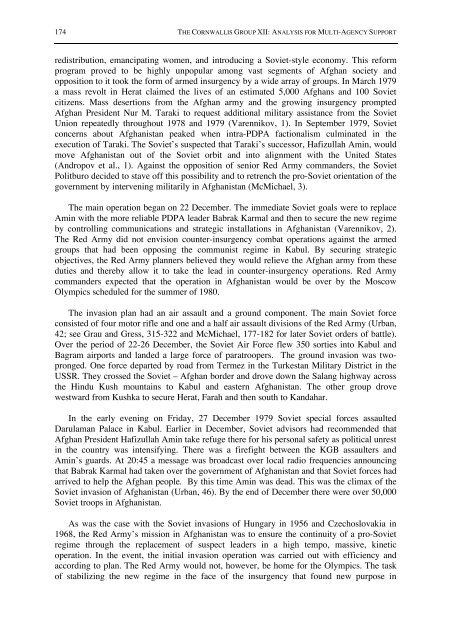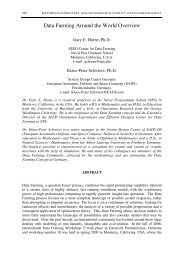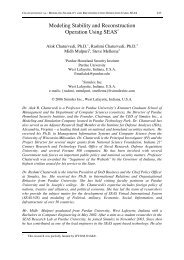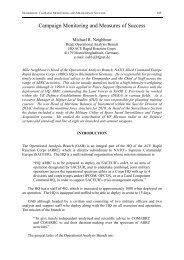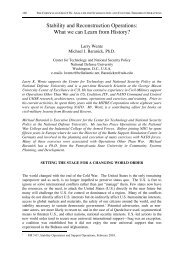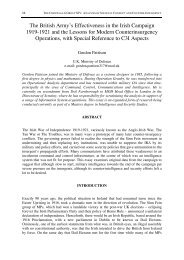Lessons Learned from the Soviet Experience in ... - Cornwallis Group
Lessons Learned from the Soviet Experience in ... - Cornwallis Group
Lessons Learned from the Soviet Experience in ... - Cornwallis Group
Create successful ePaper yourself
Turn your PDF publications into a flip-book with our unique Google optimized e-Paper software.
174 THE CORNWALLIS GROUP XII: ANALYSIS FOR MULTI-AGENCY SUPPORTredistribution, emancipat<strong>in</strong>g women, and <strong>in</strong>troduc<strong>in</strong>g a <strong>Soviet</strong>-style economy. This reformprogram proved to be highly unpopular among vast segments of Afghan society andopposition to it took <strong>the</strong> form of armed <strong>in</strong>surgency by a wide array of groups. In March 1979a mass revolt <strong>in</strong> Herat claimed <strong>the</strong> lives of an estimated 5,000 Afghans and 100 <strong>Soviet</strong>citizens. Mass desertions <strong>from</strong> <strong>the</strong> Afghan army and <strong>the</strong> grow<strong>in</strong>g <strong>in</strong>surgency promptedAfghan President Nur M. Taraki to request additional military assistance <strong>from</strong> <strong>the</strong> <strong>Soviet</strong>Union repeatedly throughout 1978 and 1979 (Varennikov, 1). In September 1979, <strong>Soviet</strong>concerns about Afghanistan peaked when <strong>in</strong>tra-PDPA factionalism culm<strong>in</strong>ated <strong>in</strong> <strong>the</strong>execution of Taraki. The <strong>Soviet</strong>’s suspected that Taraki’s successor, Hafizullah Am<strong>in</strong>, wouldmove Afghanistan out of <strong>the</strong> <strong>Soviet</strong> orbit and <strong>in</strong>to alignment with <strong>the</strong> United States(Andropov et al., 1). Aga<strong>in</strong>st <strong>the</strong> opposition of senior Red Army commanders, <strong>the</strong> <strong>Soviet</strong>Politburo decided to stave off this possibility and to retrench <strong>the</strong> pro-<strong>Soviet</strong> orientation of <strong>the</strong>government by <strong>in</strong>terven<strong>in</strong>g militarily <strong>in</strong> Afghanistan (McMichael, 3).The ma<strong>in</strong> operation began on 22 December. The immediate <strong>Soviet</strong> goals were to replaceAm<strong>in</strong> with <strong>the</strong> more reliable PDPA leader Babrak Karmal and <strong>the</strong>n to secure <strong>the</strong> new regimeby controll<strong>in</strong>g communications and strategic <strong>in</strong>stallations <strong>in</strong> Afghanistan (Varennikov, 2).The Red Army did not envision counter-<strong>in</strong>surgency combat operations aga<strong>in</strong>st <strong>the</strong> armedgroups that had been oppos<strong>in</strong>g <strong>the</strong> communist regime <strong>in</strong> Kabul. By secur<strong>in</strong>g strategicobjectives, <strong>the</strong> Red Army planners believed <strong>the</strong>y would relieve <strong>the</strong> Afghan army <strong>from</strong> <strong>the</strong>seduties and <strong>the</strong>reby allow it to take <strong>the</strong> lead <strong>in</strong> counter-<strong>in</strong>surgency operations. Red Armycommanders expected that <strong>the</strong> operation <strong>in</strong> Afghanistan would be over by <strong>the</strong> MoscowOlympics scheduled for <strong>the</strong> summer of 1980.The <strong>in</strong>vasion plan had an air assault and a ground component. The ma<strong>in</strong> <strong>Soviet</strong> forceconsisted of four motor rifle and one and a half air assault divisions of <strong>the</strong> Red Army (Urban,42; see Grau and Gress, 315-322 and McMichael, 177-182 for later <strong>Soviet</strong> orders of battle).Over <strong>the</strong> period of 22-26 December, <strong>the</strong> <strong>Soviet</strong> Air Force flew 350 sorties <strong>in</strong>to Kabul andBagram airports and landed a large force of paratroopers. The ground <strong>in</strong>vasion was twopronged.One force departed by road <strong>from</strong> Termez <strong>in</strong> <strong>the</strong> Turkestan Military District <strong>in</strong> <strong>the</strong>USSR. They crossed <strong>the</strong> <strong>Soviet</strong> – Afghan border and drove down <strong>the</strong> Salang highway across<strong>the</strong> H<strong>in</strong>du Kush mounta<strong>in</strong>s to Kabul and eastern Afghanistan. The o<strong>the</strong>r group drovewestward <strong>from</strong> Kushka to secure Herat, Farah and <strong>the</strong>n south to Kandahar.In <strong>the</strong> early even<strong>in</strong>g on Friday, 27 December 1979 <strong>Soviet</strong> special forces assaultedDarulaman Palace <strong>in</strong> Kabul. Earlier <strong>in</strong> December, <strong>Soviet</strong> advisors had recommended thatAfghan President Hafizullah Am<strong>in</strong> take refuge <strong>the</strong>re for his personal safety as political unrest<strong>in</strong> <strong>the</strong> country was <strong>in</strong>tensify<strong>in</strong>g. There was a firefight between <strong>the</strong> KGB assaulters andAm<strong>in</strong>’s guards. At 20:45 a message was broadcast over local radio frequencies announc<strong>in</strong>gthat Babrak Karmal had taken over <strong>the</strong> government of Afghanistan and that <strong>Soviet</strong> forces hadarrived to help <strong>the</strong> Afghan people. By this time Am<strong>in</strong> was dead. This was <strong>the</strong> climax of <strong>the</strong><strong>Soviet</strong> <strong>in</strong>vasion of Afghanistan (Urban, 46). By <strong>the</strong> end of December <strong>the</strong>re were over 50,000<strong>Soviet</strong> troops <strong>in</strong> Afghanistan.As was <strong>the</strong> case with <strong>the</strong> <strong>Soviet</strong> <strong>in</strong>vasions of Hungary <strong>in</strong> 1956 and Czechoslovakia <strong>in</strong>1968, <strong>the</strong> Red Army’s mission <strong>in</strong> Afghanistan was to ensure <strong>the</strong> cont<strong>in</strong>uity of a pro-<strong>Soviet</strong>regime through <strong>the</strong> replacement of suspect leaders <strong>in</strong> a high tempo, massive, k<strong>in</strong>eticoperation. In <strong>the</strong> event, <strong>the</strong> <strong>in</strong>itial <strong>in</strong>vasion operation was carried out with efficiency andaccord<strong>in</strong>g to plan. The Red Army would not, however, be home for <strong>the</strong> Olympics. The taskof stabiliz<strong>in</strong>g <strong>the</strong> new regime <strong>in</strong> <strong>the</strong> face of <strong>the</strong> <strong>in</strong>surgency that found new purpose <strong>in</strong>


